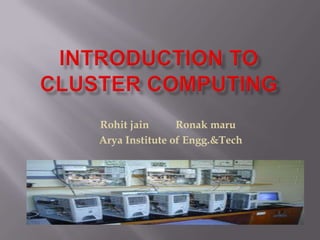
Cluster computing pptl (2)
- 1. Rohit jain Ronak maru Arya Institute of Engg.&Tech
- 2. Introduction Types of cluster :- o High Availability or Failover Clusters. o Load Balancing Cluster. o Parallel/Distributed Processing Clusters. Cluster Component. Cluster Application. How Does It Work? Cluster benefits
- 3. A computer cluster is a group of loosely coupled computers that work together closely so that in many respects it can be viewed as though it were a single computer. Clusters are commonly connected through fast local area networks. Clusters are usually deployed to improve speed and/or reliability over that provided by a single computer, while typically being much more cost effective than single computer the of comparable speed or reliability .
- 4. In cluster computing each node within a cluster is an independent system, with its own operating system, private memory, and, in some cases, its own file system. Because the processors on one node cannot directly access the memory on the other nodes, programs or software run on clusters usually employ a procedure called "message passing" to get data and execution code from one node to another. Clusters have evolved to support applications ranging from ecommerce to high performance database applications. Cluster computing can also be used as a relatively low- cost form of parallel processing for scientific and other applications that lend themselves to parallel operations.
- 6. 1. High Availability or Failover Clusters 2. Load Balancing Cluster 3. Parallel/Distributed Processing Clusters
- 7. These clusters are designed to provide uninterrupted availability of data or services (typically web services) to the end-user community. if a node fails, the service can be restored without affecting the availability of the services provided by the cluster. While the application will still be available, there will be a performance drop due to the missing node. The purpose of these clusters is to ensure that a single instance of an application is only ever running on one cluster member at a time but if and when that cluster member is no longer available, the application will failover to another cluster member.
- 10. This type of cluster distributes incoming requests for resources or content among multiple nodes running the same programs or having the same content. Both the high availability and load-balancing cluster technologies can be combined to increase the reliability, availability, and scalability of application and data resources that are widely deployed for web, mail, news, or FTP services. Every node in the cluster is able to handle requests for the same content or application. This type of distribution is typically seen in a web-hosting environment.
- 13. parallel processing was performed by multiple processors in a specially designed parallel computer. These are systems in which multiple processors share a single memory and bus interface within a single computer. These types of cluster increase availability, performance, and scalability for applications, particularly computationally or data intensive tasks.
- 14. The basic building blocks of clusters are broken down into multiple categories: 1. Cluster Nodes 2. Cluster Network 3. Network Characterization
- 15. There are three primary categories of applications that use parallel clusters: 1. Compute Intensive Application. 2. Data or I/O Intensive Applications. 3. Transaction Intensive Applications.
- 16. A user submits a job to the head node. The job identifies the application to run on the cluster. The job scheduler on the head node assigns each task defined by the job to a node and then starts each application instance on the assigned node. Results from each of the application instances are returned to the client via files or databases.
- 18. The main benefits of clusters are: 1. Availability 2. Performance 3. Scalability These benefits map to needs of today's enterprise business, education, military and scientific community infrastructures.
